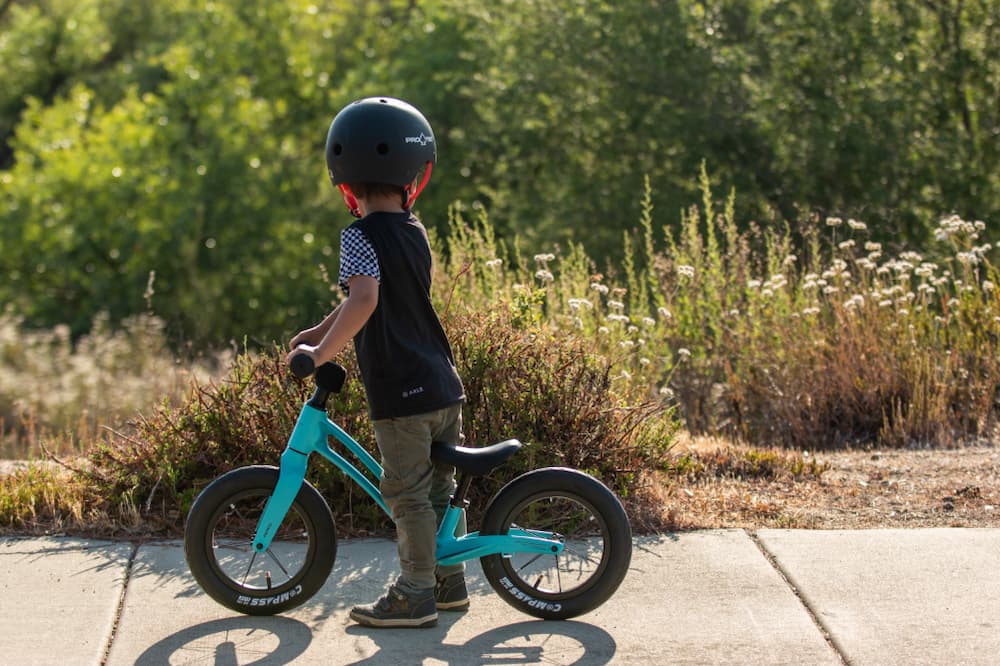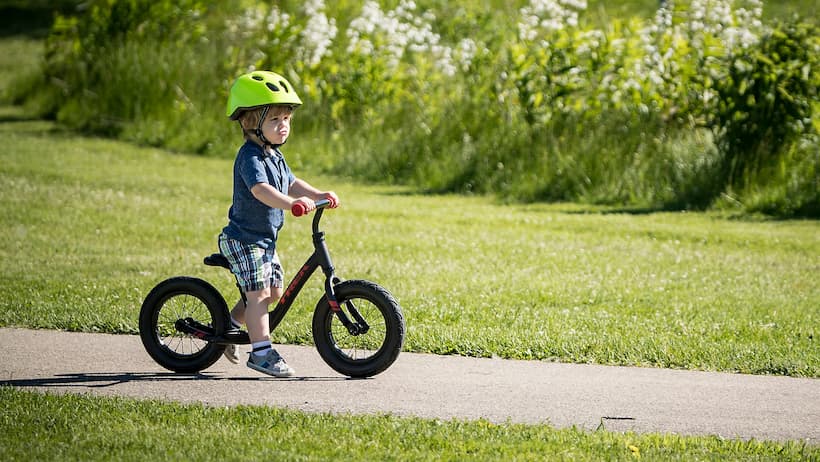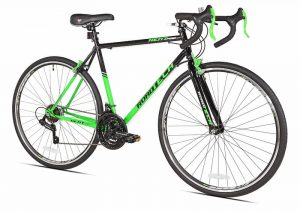Unpedalled bicycles are known as balance bikes. It lacks a drivetrain but has a frame, fork, handlebars, and wheels. Kids propel themselves forward by pushing off the ground with their feet like Fred Flintstone.
Training wheels, also known as stabilisers, are absent from balance bikes. Kids don’t need stabilisers because they have their feet on the ground, allowing them to develop their balance and coordination. They can then move on to pedals when they are prepared and self-assured.
Continue reading.
Table of Contents
Designs Of Balance Bike
Both metal and wood have been used to create balance bikes. It can be a normal bicycle with pedals and related parts removed, or it can be purpose-built (especially for very small children, for whom normal bicycles are generally not available). Some have solid foam or air tires and are equipped with brakes. Flat handlebars are a common feature of commercially available designs.
A balance bicycle must be small enough for the rider to comfortably walk it while seated in the saddle with both feet flat on the ground in order for it to work properly. Standing over the saddle and then sitting in it, the rider moves the bicycle first. Eventually, the rider feels comfortable enough to run and “scoot” while riding the bicycle, then to lift both feet off the ground and cruise while balancing on the two wheels.
History Of Balance Bike
Karl Drais created the dandy horse, the first two-wheeled vehicle without pedals, which later evolved into the balance bicycle. His first reported ride from Mannheim to Rheinau (now a section of Mannheim) took place on June 12, 1817. Drais was a German inventor and invented the Laufmaschine (“running machine”), also later called the velocipede, draisine (English) or “draisienne” (French), or known by the moniker “dandy horse.” This marked the introduction of mechanized personal transportation by incorporating the two-wheeler design principle that is the foundation of the bicycle and motorcycle. In 1997, German designer Rolf Mertens developed the first commercially produced Laufrad “running bike” called LIKEaBIKE.
The Best Age For A Child To Start On A Balance Bike
Between 18 months and 2 years old is the ideal age for kids to start on a balance bike. This is the average age range when a child is physically and developmentally ready to start balancing a bike.
Although it’s best for kids to begin “balance-biking” as young as possible, they can still benefit from it even if they start out a little bit older.
Any age of child can benefit from riding a balance bike, which will help them gain strength, balance, and coordination as they learn to pedal.
Most importantly, check that the bike is the right size for your child, otherwise it will delay their cycling development and make it more difficult to learn. See more about What Is A Pit Bike?
Why Your Toddler (Or Preschooler) Needs A Balance Bike
A balance bike is not only entertaining, but it also promotes confidence and the development of gross motor skills. It also makes the transition to a pedal bike simple. Here are some of the top reasons you should get a balance bike for your toddler if they don’t have one already.
Gross-motor Skill Development
This is the least-cited yet most important reason for a balance bike. As a mom, I’m always looking for materials and toys that are developmentally-appropriate for my child.
One of the best toys available for assisting your child’s development of gross motor skills is a balance bike. Learning balance and coordination is crucial for injury prevention, self-regulation, and building a foundation for future fine motor skill development, according to Kid Sense Child Development.
Balance bikes also help develop core muscle strength and endurance.
Easy Transition To A Pedal Bike
Most of us still remember clearly the first time we learned to ride a bike, and those memories are often not pleasant ones. I crashed on my face and ended up with a bloody mouth on my first ride without training wheels.
Children who start out on a balance bike typically make the switch to a pedal bike without any training wheels. Young children who begin riding a balance bike at an early age (18 to 24 months) are frequently riding a pedal bike without training wheels by the time they are 3 years old. Kids can learn about balance and motion on the balance bike, which also serves as a secure starting point for learning to ride a pedal bike.
Exercise
We’ve all heard the reports on the prevalence of childhood obesity in the United States. Children are alarmingly under- and overweight. Childhood obesity has increased by more than a factor of two over the past 30 years, according to the CDC.
Fortunately, when it comes to young kids, they don’t view activity as “exercise” — they view it as “fun.” When it comes to riding bikes, this is especially true.
The other benefit of balance bikes is that they help toddlers expend some of their boundless energy. My 2-year-old can manage a couple miles on his bike.
When he gets home, he takes a really good nap. Score an extra hour of free time for mom and dad.
Fun
This is the most evident benefit of getting your child a balance bike. Bike love is a common trait among children and affects almost all of them. A bike will bring joy and happiness to your child and put a smile on their face.

Self-confidence
Nothing makes my son’s little chest swell up like riding his balance bike, in my opinion. Every time he rides off a “ledge” or a “jump” or manages to coast ten feet without stopping, he just beams with pride.
I appreciate how his balance bike is fostering his sense of athletic prowess and body confidence. It is incredibly difficult for toddlers, especially those who are very young (i.e. walking fast enough to keep up with mom and dad) that it makes them feel amazing to be able to ride a bike.
Exposure To The Outdoors
One of the best things about bikes is that it encourages us to spend time outside. My son loves to ride his bike, but it is difficult to get him as excited about anything else as he is about cartoons.
Most children today don’t spend enough time in nature, which results in a variety of behavioral and emotional issues. A well-constructed balance bike can be used for more than just cruising down the driveway; it can also be used to cruise along your favorite hiking trail or on the park’s grass.
Cost Effective
We all spend outrageous sums of money on toys. Most of these items are discarded in favor of something new after a season or two of interest. Plastic toys break and end up in the landfill.
A high-quality balance bike, on the other hand, can be used by your child for a number of years before still being in good enough condition to be passed down to a younger sibling or sold on Craigslist. Even when a child transitions to a pedal bike, they frequently continue to enjoy riding balance bikes for tricks in the backyard or at the BMX track. A balance bike is therefore both affordable and environmentally friendly.
Choose The Right Balance Bike For Your Child
The balance bike with the best price, size, weight, function, customer service, and sustainability is the one you should purchase.
It’s up to you to weigh up the different considerations and determine which is best for your child.
The LittleBig bike is a great value overall in our opinion because of its durability, functionality, aesthetics, sustainability, personal service, and cost.
Things To Consider When Shopping For A Balance Bike
If you’re not intimately familiar with balance bikes, it is hard to know what you should be looking for. Why do some bicycles cost more than others?
How do you choose the right bike for your child? When purchasing a balance bike, there are seven things that we advise keeping an eye out for or taking into account.
Balance Bike Tires
The two main types of balance bike tires are pneumatic (air) tires and solid tires made of foam or plastic. If you can afford it, we always recommend choosing a balance bike with pneumatic (air) tires.
The design of adult bicycle tires is imitated by pneumatic tires, which also have tubes inside. Kids can ride their bikes on a variety of surfaces, including gravel, dirt, and the lawn, because they offer noticeably better traction.
This might be less important for an 18-month old who is riding around the house or on the patio—but remember, they will want to venture out sooner than you realize. On the flip side, the one big advantage of foam tires is that they will never go flat. This can be a huge benefit for people who don’t want to fuss with bike maintenance.
The bicycle on the left in the image below has pneumatic (air) tires, while the bicycle on the right has tires made of foam or plastic. The tread and quality of the two different tire types differ noticeably from one another.
Balance Bike Wheel Size
A balance bike’s size can generally be predicted by its wheel size. The bike gets smaller the smaller the wheels are.
Toddlers will be best off on 12″ wheels, and preschoolers will generally be best off on 14″ wheels. There are also a few (but not many) 16″ wheel balance bikes that are best suited for older kids who have not yet mastered a balance bike.
Balance Bike Seat Height
You should be mindful of the balance bike’s minimum and maximum seat heights when selecting one. Measure your child’s inseam and ensure that it is at least as long as the minimum seat height.
A bike that is too big will only frustrate and discourage your child. The bicycle can, however, grow with your child more if the maximum seat height is higher. To maximize the life of the bike, we advise looking for a balance bike with a minimum seat height that matches your child’s inseam or is just a little bit lower.
Frame Material
There is no best frame material; each has advantages of their own. Steel is a traditional material for bicycles, and is known for being strong and durable (something that’s important when we’re talking about toddlers).
Aluminum is lightweight and has the look and feel of a “real” grown-up bicycle. Wood is both aesthetically pleasing and environmentally friendly. Furthermore, composite frames are perfect for anyone looking for a lightweight bike that is also simple to maintain.
Brakes
Most balance bikes, especially cheaper ones, do not come with any brakes. This is acceptable for very young toddlers because they lack the eye-hand coordination needed to use a hand brake. They also aren’t moving very fast yet and do just fine stopping with their feet.
By 3 or 4, however, a brake becomes increasingly important (and can save the soles of a lot of shoes). A hand brake is especially important if your family enjoys going to the pump track or bike park, or if you live in an area with a lot of hills. Last but not least, teaching your child how to use a hand brake while they are still riding a balance bike can make the switch to a pedal bike with handbrakes much simpler.
Bike Weight
A bike that is lighter in weight will typically be preferred over one that is heavier. This is especially true for very young kids (1 and 2 years old). A lighter bike is always easier to control and maneuver. We recommend choosing the lightest bike you can find within your price-range.
Price
Better than no bike is a bike of any kind. Expect to spend $100 to $150 to get a good quality bike—one that will last a while, be safe, and will ride well for your kiddo. Bikes costing more than $150 come with extra bells and whistles, such as unique colors, carbon-fiber handlebars, and extra-sturdy tires.
Ways To Encourage A Toddler To Use Their Balance Bike
Okay, so you have a balance bike. Now what?!
Some young children pick up their balance bikes immediately and without prompting. Some people, particularly young toddlers, require a little assistance learning to ride a balance bike. They become impatient or lose interest.
Here are our top five suggestions for igniting their enthusiasm for riding.
Ride Your Bike Too
Nothing makes toddlers happier than to mimic what their parents do. My husband and I are both ardent cyclists, and my son has grown up watching us ride since he was only a few months old.
He was shaking with excitement when he finally got his first balance bike (a little before 18 months). Even if it is just riding around the driveway, seeing you ride is a sure way to create interest in your little.
Better still if they have an older sibling or friend to watch ride. A little “peer pressure” can go a long way.
Find A Balance Bike That Fits You
If your kiddo is frustrated with their bike, there is a good chance it is too big or too heavy. Pick a lightweight bike with a low stand-over height that’s designed for the youngest kids.
If you already have a bike and don’t want to spend money on a new one, make sure the seatpost and handlebars are lowered all the way. If that doesn’t work, let them grow a little taller while putting the bike away for a few months. It is amazing how quickly they will grow and be ready for it!
Spend 10 To 15 Minutes A Day Exercising
At this age, repetition is essential for children, so make an effort to take them outside and let them ride their balance bikes for a short while each day. That said, don’t overwhelm them.
Allow them to try for a while, and if they start to lose interest, move on. Try again tomorrow.
Find A Hill.
No, not a big one—just a slight incline where they can get a feel for momentum. You can use a small bike ramp, a sloping driveway, or a grassy hill at the playground.
For some kids, this will make all the difference. This is especially true for young children who are unable to move past the balance biking walk or scoot phases.
Walk next to them and place your hand on their back if they require assurance.
Select Some Enjoyable Accessories
My child adores his helmet. Sometimes he rides his bike just so he can wear his helmet.
Other children might appreciate bike gloves, a bell on their handlebars, or a basket to carry their teddy bear in. No, this won’t help them learn to ride a bike, but it might encourage them to ride their bike more frequently.
Go On An Adventure
Try going somewhere if you’ve only used the balance bike in the driveway. Try to locate a quiet dirt road, a grassy field, or even a rocky area. The thought of exploration and adventure appeals to some young children.
Bring It Inside
On the other hand, you might try bringing the balance bike inside. Leave it in their playroom or another location that they frequently visit. They may be more inclined to give it a try on their own in a relaxed, comfortable setting.
This is particularly true for very young toddlers who are likely to have a short attention span. They might only ride for a minute or two at a time, but after a few weeks or months, they’ll start to gain the skills and confidence they need to succeed.
Practice Patience
Be patient until the end. Some children can ride without any issues at the age of 18 months. Others don’t express interest until much later—like four or five—and then only briefly. Every child is unique.
The best thing you can do is include cycling in your family’s daily routine if you think it’s important that they ride. Get a trailer or child seat and go for rides that way. In no time, they will demand to be riding on their own.
Balance Bike Vs Pedal Bike Fitted With Stabilisers
Due to the child’s weight shifting from one stabiliser to the other, a bike with stabilisers is more likely to tip unexpectedly from side to side. Because they will topple over, bikes with stabilisers cannot be used on sloped or uneven surfaces.
A balance bike presents children with a greater challenge to actively maintain balance, which aids in the development of the skills required to cycle quickly and independently.
Conclusion
A balance bike is a bike that doesn’t have pedals, to put it simply. Children will straddle the seat and scoot along with their feet to move forward. Although this may seem like a Flintstones-type method, a balance bike teaches kids just that – balance. A “coordination bike?” A “confidence bike?” An “independence bike?” Although balance bikes help children develop all these things, it just doesn’t sound right, and “Balance Bike” has a nice ring to it.
I’m grateful you read.



